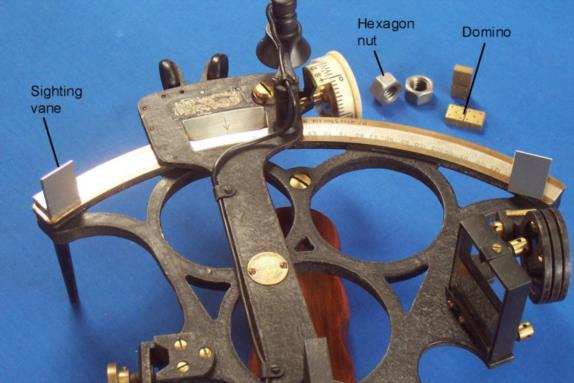
NavList:
A Community Devoted to the Preservation and Practice of Celestial Navigation and Other Methods of Traditional Wayfinding
Re: Collimation test
From: Bill Morris
Date: 2009 Jul 20, 21:54 -0700
From: Bill Morris
Date: 2009 Jul 20, 21:54 -0700
To collimate the telescope (see attachment Coll1.jpg): 1) Set the sextant at zero and lay it down so the frame is horizontal. 2) Place a sighting vane (diopter)each end of the arc parallel to the axis of the telescope at about 0 and 120 degrees and look at a distant (<1000 metres) object so that the object and the tops of both vanes coincide. Better still, align them with a distant horizon. Wedge the sextant as necessary to align with the object. 3) Look through the x 6 telescope. The chosen object should be in the centre of the field in the vertical axis. If it is not, make it so by using the adjusting screws. Do not overtighten the screws. The telescope mount is easily distorted. This is a fundamental method that does not need any measuring. To place the index mirror perpendicular to the frame (see attachment Perp3 jpg)): 1) With the instrument horizontal, set the index arm to about 40 degrees 2) Place a vane at 0 and 120 degrees, so that they face the axis of the instrument. 2) Look past the lower (right) edge of the index mirror at the vane set at zero. You should be able to see the other vane reflected in the mirror at the lower right) edge. You may need to adjust the position of the index arm slightly. The tops of direct and reflected images should be in a straight line. If they are not, make them so. If you have your eye 80 to 100 mm from the mirror, the line appears to be continuous through the frame of the mirror. This method makes the adjustment at the approximate height of the viewing axis of the instrument though is of no importance when the apparent reflective surface of the index mirror lies on the axis of the index arm. Even when it does not, as in instruments like the SNO-T, which has a first surface mirror, the error is small, as long as you view the images close to the plane of the frame. Bill Morris Pukenui New Zealand --~--~---------~--~----~------------~-------~--~----~ NavList message boards: www.fer3.com/arc Or post by email to: NavList@fer3.com To , email NavList-@fer3.com -~----------~----~----~----~------~----~------~--~---








